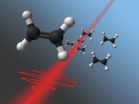(Press-News.org) Usually, chemical reactions just take their course, much like a ball rolling downhill. However, it is also possible to deliberately control chemical reactions: at the Vienna University of Technology, molecules are hit with femtosecond laser pulses, changing the distribution of electrons in the molecule. This interaction is so short that at first it does not have any discernable influence on the atomic nuclei, which have much more mass than the electrons. However, the disturbance of the electron distribution can still initiate chemical processes and eventually separate the nuclei from each other. The properties of the laser pulse determine which chemical final products are created.
Controlling Chemistry
Chemists can choose which molecules they want to take part in a chemical reaction – but the result is usually determined by the physical and chemical properties of molecules and by external parameters such as the temperature. The reaction itself cannot be controlled. Researchers at the Vienna University of Technology (Photonics Institute) have now succeeded in directly inducing the splitting of hydrocarbons such as ethylene (C2H4) or acetlyene (C2H2) into smaller fragments.
"We are using two different laser pulses", says Markus Kitzler (TU Vienna). "The first pulse takes about 50 femtoseconds and makes the molecules rotate at different speeds." After some time, all molecules are approximately aligned - and then the second laser pulse is applied, which only lasts for five femtoseconds, less than two oscillations of the light wave. This pulse changes the state of the electrons; it can even remove electrons from the molecule.
Selecting a Reaction Path
Electrons weigh much less than atomic nuclei. Therefore the electrons can be influenced dramatically by the laser pulse, whereas the heavier nuclei are much too inert for any observable motion in this short period of time. If, however, exactly the right electrons are removed from the molecule, the molecule can be made to break at a specific position. That way, acetylene (C2H2) can be broken up into CH2+, CH+, or carbon ions (C+). "Various reaction paths are possible. For the first time, we managed to distinguish these paths and select the reaction we want", says Markus Kitzler.
An extremely short laser pulse – five femtoseconds (5.10^(-15) seconds) are just five millionths of a billionth of a second – initiates a chemical process, which takes place on a much larger timescale. This is similar to a short explosion at precisely the right places, which may cause a huge building to sway and eventually collapse.
The composition of chemical end products can be controlled by a number of different parameters: The alignment of the molecules by the first laser pulse, the duration and the intensity of the second pulse, which ionizes the molecules.
INFORMATION:
The experiments were done by Markus Kitzler's research team, his postdoc Xinhua Xie played a leading role in data analysis. Katharinia Doblhoff-Dier and Prof. Stefanie Gräfe from Jena University and Erik Lötstedt, from Tokyo University contributed model calculations, which were invaluable for the interpretation of the experimental results.
The experimental results have now been published in two scientific publications: In "Physical Review Letters" and "Physical Review X".
Link to PRX-article: prx/abstract/10.1103/PhysRevX.4.021005
Further information:
Dr. Markus Kitzler-Zeiler
Photonics Institute
Vienna University of Technology
Gusshausstraße 25-29, 1040 Vienna
T: +43-1-58801-38772
markus.kitzler@tuwien.ac.at
Steering chemical reactions with laser pulses
With ultra-short laser pulses, chemical reactions can be controlled at the Vienna University of Technology; electrons have little mass and are therefore influenced by the laser, whereas the atomic nuclei are much heavier and are hardly affected
2014-04-23
ELSE PRESS RELEASES FROM THIS DATE:
Uniting community development efforts could benefit members of underserved communities
2014-04-23
COLUMBIA, Mo. –Research shows that wealth inequality creates barriers to community development, due to the widespread effects of poverty. A report by the United Nations Children's Fund shows that more than one in five children in the United States falls below the poverty line. Although many organizations address poverty, they often serve similar demographics and may compete for clients and resources. Recently, University of Missouri researchers studied Cooperative Extension's efforts to link community development organizations and concluded Extension is the hub that can ...
Remote surveillance may increase chance of survival for 'uncontacted' Brazilian tribes
2014-04-23
COLUMBIA, Mo. – Lowland South America, including the Amazon Basin, harbors most of the last indigenous societies that have limited contact with the outside world. Studying these tribes, located deep within Amazonian rainforests, gives scientists a glimpse at what tribal cultures may have been like before the arrival of Europeans. Now, researchers at the University of Missouri have used satellite images to assess the demographic health of one particular village of isolated people on the border between Brazil and Peru. Remote surveillance is the only method to safely track ...
Impact of whooping cough vaccination revealed
2014-04-23
The most comprehensive study to date of the family of bacteria that causes whooping cough points to more effective vaccine strategies and reveals surprising findings about the bacteria's origin and evolution. The new results could alter public health strategies to control this respiratory disease, which kills 195,000 children worldwide each year.
Genomic analysis of 343 strains of the Bordetella pertussis bacteria from around the world collected over the last 100 years illustrates how vaccination has shaped its evolution. Since its introduction across the globe between ...
Loss of memory in Alzheimer's mice models reversed through gene therapy
2014-04-23
Alzheimer's disease is the first cause of dementia and affects some 400,000 people in Spain alone. However, no effective cure has yet been found. One of the reasons for this is the lack of knowledge on the cellular mechanisms which cause alterations in nerve transmissions and the loss of memory in the initial stages of the disease.
Researchers from the Institute of Neuroscience at the Universitat Autònoma de Barcelona have discovered the cellular mechanism involved in memory consolidation and were able to develop a gene therapy which reverses the loss of memory in mice ...
Liquid spacetime
2014-04-23
What if spacetime were a kind of fluid? This is the question tackled by theoretical physicists working on quantum gravity by creating models attempting to reconcile gravity and quantum mechanics. Some of these models predict that spacetime at the Planck scale (10-33cm) is no longer continuous – as held by classical physics – but discrete in nature. Just like the solids or fluids we come into contact with every day, which can be seen as made up of atoms and molecules when observed at sufficient resolution. A structure of this kind generally implies, at very high energies, ...
How Australia got the hump with 1 million feral camels
2014-04-23
A new study by a University of Exeter researcher has shed light on how an estimated one million-strong population of wild camels thriving in Australia's remote outback have become reviled as pests and culled on a large scale.
Sarah Crowley, of the Environment and Sustainability Institute at the University of Exeter's Penryn Campus, explored the history of the camel in Australia, from their historic role helping to create the country's infrastructure through to their current status as unwelcome "invader."
The deserts of the Australian outback are a notoriously inhospitable ...
Ravens understand the relations among others
2014-04-23
Like many social mammals, ravens form different types of social relationships – they may be friends, kin, or partners and they also form strict dominance relations. From a cognitive perspective, understanding one's own relationships to others is a key ability in daily social life ("knowing who is nice or not"). Yet, understanding also the relationships group members have with each other sets the stage for "political" maneuvers ("knowing who might support whom"). The results of this study have been published in the scientific journal Nature Communications.
A team of researchers ...
Experience What Its Like to Fly...Learn About Aviation and What Pilots Need to Know to Fly An Airplane; Experimental Aircraft Association's (EAA) Young Eagles Program Hosts Flight Rally
2014-04-23
Orange County kids and teens, ages 8-17 will have a chance to take to the skies on Saturday, April 26th 2010, when Orange County's EAA Chapter 92 hosts a Young Eagles Flight Rally. The rally is part of the EAA's Young Eagles program, created to expose kids and teens to the world of aviation. Since the Young Eagles program was launched in 1992, Volunteer EAA pilots have flown more than 1.8 million children.
"Free airplane rides are just part of the experience," states Robert Baker, spokesman for the event. "We hope to build one-to-one relationships between pilots and ...
East Coast Wings & Grill Blazes to the Top with Sizzling Achievements
2014-04-23
East Coast Wings & Grill, a casual dining restaurant known for its 75 flavors of award-winning buffalo-style wings, is elevating the climate of casual family dining by focusing on success one unit at a time.
Set to average more than 23 percent new unit growth in 2014 and 10 years of positive same store sales, the cutting-edge franchise is leading the buffalo wing segment in profitability and franchisee satisfaction. East Coast Wings & Grill grew its Earnings Before Interest, Taxes, Depreciation and Amortization (EBITDA) by 1.05 percent in 2013 to a 17.6 unit ...
ArisiTol with CBD that Helps People with Pain and Inflammation Launches Today
2014-04-23
TWIN FALLS BIOTECH today announced a new, all-natural dietary supplement containing CBD that can help people who are suffering from pain and inflammation called ArisiTol and is available nationwide starting today. ArisiTol gives consumers access to a product that can help treat their pain and inflammation without a prescription. "We are so excited about the launch of this fabulous product for people suffering from pain." Says David Mouser, CEO of Twin Falls Biotech. "We've seen so many great stories in the media lately where CBD has been able to help with so many ailments ...
LAST 30 PRESS RELEASES:
“Gifted word learner” dogs can pick up new words by overhearing their owners’ talk
More data, more sharing can help avoid misinterpreting “smoking gun” signals in topological physics
An illegal fentanyl supply shock may have contributed to a dramatic decline in deaths
Some dogs can learn new words by eavesdropping on their owners
Scientists trace facial gestures back to their source. before a smile appears, the brain has already decided
Is “Smoking Gun” evidence enough to prove scientific discovery?
Scientists find microbes enhance the benefits of trees by removing greenhouse gases
KAIST-Yonsei team identifies origin cells for malignant brain tumor common in young adults
Team discovers unexpected oscillation states in magnetic vortices
How the brain creates facial expressions
Researchers observe gas outflow driven by a jet from an active galactic nucleus
Pitt student finds familiar structure just 2 billion years after the Big Bang
Evidence of cross-regional marine plastic pollution in green sea turtles
Patients with clonal hematopoiesis have increased heart disease risk following cancer treatment
Stem cell therapy for stroke shows how cells find their way in the brain
Environment: Up to 4,700 tonnes of litter flows down the Rhine each year
Maternal vaccine receipt and infant hospital and emergency visits for influenza and pertussis
Interim safety of RSVpreF vaccination during pregnancy
Stem cell engineering breakthrough paves way for next-generation living drugs
California grants $7.4 million to advance gene-edited stem cell therapy for Friedreich’s ataxia
Victoria’s Secret grant backs cutting-edge ovarian cancer research
Research paves the way for safer colonoscopy bowel prep for people with compromised gut health
JMIR Publications and Sweden's National Library announce renewal and expansion of flat-fee unlimited open access partnership for 2026
A new 3D-printed solar cell that’s transparent and color-tunable
IV iron is the cost-effective treatment for women with iron deficiency anemia and heavy menstrual bleeding
Doing good pays off: Environmentally and socially responsible companies drive value and market efficiency
City of Hope and Cellares to automate manufacturing of solid tumor CAR T cell therapy
Short-circuiting pancreatic cancer
Groundbreaking mapping: how many ghost particles all the Milky Way’s stars send towards Earth
JBNU researchers propose hierarchical porous copper nanosheet-based triboelectric nanogenerators
[Press-News.org] Steering chemical reactions with laser pulsesWith ultra-short laser pulses, chemical reactions can be controlled at the Vienna University of Technology; electrons have little mass and are therefore influenced by the laser, whereas the atomic nuclei are much heavier and are hardly affected





